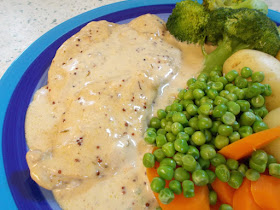Right at this moment, I'm on a white meat only diet following on from a really bad gout attack and I'm so glad that I remembered this one. Eating just chicken, turkey and white fish can get a bit ho hum, even after just a week. So it was nice to have chicken with a lovely unctuous, tasty sauce and I'm only surprised that I haven't got around to blogging it before now!
Another good thing about this recipe is that if you ever find yourself with no onions but a tub of cream in the fridge and chicken in the freezer, you're half way there. It's not often, these days, you find a recipe that doesn't include onion. I've often pondered on including a sauteed onion or maybe some garlic in the sauce but always reject the idea on the basis that the sauce is so good without it, why mess with perfection?
As for Cook's Notes, there's really only one you need to be aware of which is to monitor the temperature of the pan when you're frying the chicken. Of course, you don't want your chicken to burn, but equally you really don't want it to be more than a gentle golden brown or your sauce could end up a little bitter. It all depends on your particular pan. You know it best, so just keep your eye on it during the cooking.
Mmmmnnn, I could eat this all over again today if I had the chicken!
CHICKEN IN A MARSALA & MUSTARD CREAM SAUCE (serves 3)
Ingredients :
3 boneless, skinless chicken breasts
a pinch of sea salt
1 tbsp olive or rapeseed oil
120ml Marsala wine (or Mead, or Sherry)
2 tsp wholegrain mustard
100ml water
1 tsp low salt chicken stock granules (or half a low salt stock cube)
a pinch of ground black pepper
1 tsp thyme
150ml double cream
1 tsp cornflour, let down with a small amount of water.
Method :
Trim each chicken breast of any gristle or fat, then slice each breast through horizontally from the thick end to the thin end, creating two thin halves.
Place the olive or rapeseed oil into a frying pan and heat until sizzly. Gently lay each chicken breast down - and leave it alone apart from to sprinkle with a small amount of sea salt. You are aiming to achieve some colour on the chicken breasts, so they will need to stay in one position until they achieve a lovely golden colour.
Flip each breast over onto the other side and again, leave it alone to cook and gain colour for another few minutes.
Remove the chicken to a warmed plate, it doesn't matter if it isn't quite cooked through - it will finish cooking once it is in the sauce.
Pour the wine into the pan and deglaze by stirring and releasing any crispy bits that may be stuck to the pan. All these are flavour!
Once the wine has reduced by half, add the mustard, water, stock granules, black pepper and thyme. Stir thoroughly to combine.
Add the cream and stir through, then return the chicken to the pan, together with any juices that have accumulated under the chicken. Stir gently and allow the sauce to simmer.
When you are satisfied that the chicken is cooked through, if necessary add the cornflour/water mix and stir to combine. Once the sauce has thickened to your preferred consistency, serve with a selection of steamed vegetables and new potatoes.
Printable version
1 tbsp olive or rapeseed oil
120ml Marsala wine (or Mead, or Sherry)
2 tsp wholegrain mustard
100ml water
1 tsp low salt chicken stock granules (or half a low salt stock cube)
a pinch of ground black pepper
1 tsp thyme
150ml double cream
1 tsp cornflour, let down with a small amount of water.
Method :
Trim each chicken breast of any gristle or fat, then slice each breast through horizontally from the thick end to the thin end, creating two thin halves.
Place the olive or rapeseed oil into a frying pan and heat until sizzly. Gently lay each chicken breast down - and leave it alone apart from to sprinkle with a small amount of sea salt. You are aiming to achieve some colour on the chicken breasts, so they will need to stay in one position until they achieve a lovely golden colour.
Flip each breast over onto the other side and again, leave it alone to cook and gain colour for another few minutes.
Remove the chicken to a warmed plate, it doesn't matter if it isn't quite cooked through - it will finish cooking once it is in the sauce.
Pour the wine into the pan and deglaze by stirring and releasing any crispy bits that may be stuck to the pan. All these are flavour!
Once the wine has reduced by half, add the mustard, water, stock granules, black pepper and thyme. Stir thoroughly to combine.
Add the cream and stir through, then return the chicken to the pan, together with any juices that have accumulated under the chicken. Stir gently and allow the sauce to simmer.
When you are satisfied that the chicken is cooked through, if necessary add the cornflour/water mix and stir to combine. Once the sauce has thickened to your preferred consistency, serve with a selection of steamed vegetables and new potatoes.
Printable version
























